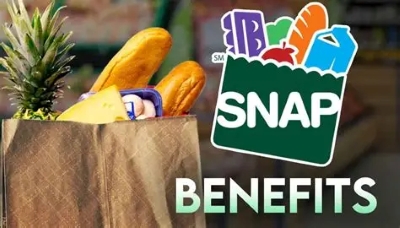The Latest: Supreme Court Judge Ketanji Brown issues pause in funding until courts decide
By Andrew Harris
The Supplemental Nutrition Assistance Program has never been in more headlines. In 1964 President Lyndon Johnson sign the “Food Stamp Act” which according the USDA was created with two goals, “strengthening the agricultural economy and providing improved levels of nutrition among low-income households.”
Since 1964 the program has grown from 500,000 recipients to the current 42 million who receive monthly food credits that are widely accepted at grocery stores and other food locations. The program’s dual benefit is to improve the economic marketplace for US farmers. Approximately 10% of US farm production is purchased through the SNAP program and the program acts to boost demand in certain agriculture sectors.
SNAP has been in the news since before the recent federal government shutdown created a national funding crisis. Earlier in 2025, lawmakers passed the “Big Beautiful Bill,” H.R. 1, which ended exemptions for states who did not wish to enforce the work requirement. In New York, that work requirement boils down to asking adults 18-64 years in age without young children or disability, to certify 20 hours per week of contributions to society. That 20 hours can be spent in school or training, at work, or volunteering. Local Social Services departments are charged with the certification process.

Read our previous reporting on SNAP work requirements
Since the federal government shutdown started on October 1st so did a countdown to an interruption in SNAP benefits nationwide. As of November 8th, the US Senate continues to debate on ending the shutdown and restoring SNAP funding. The highest courts in the country are hearing both sides.
Here is a timeline on the rollercoaster ride through the government and courts:
- On August 9th, 2025 Steuben County legislators sent a letter to President Trump asking for relief for the changes that HR. 1 made to SNAP and Medicaid benefits. The three legislators warned that “300,000 households are expected to lose some/all SNAP benefits” Read that letter here.
- In mid-October the NYS warned that new federal work requirements would start on November 1st, six months earlier than expected. Counties, who administer the SNAP program began scramble to contact those impacted for registration in order to avoid any sudden loss of benefits. Our reporting on that work requirement was the most widely read story since our efforts began in 2020.
- Days later, the USDA announces that due to the ongoing federal government shutdown, funding for November 1 benefits is in question. The USDA announced the emergency fund was only enough for about half of the total funding needed to provide November benefits. More details from October 17.
- On October 28, NY and twenty-five other states took the USDA to federal court declaring that it was illegal to withhold funding for the SNAP program. The USDA posted a public notice on USDA.gov stating, “Senate Democrats are withholding services to the American people in exchange for healthcare for illegals, gender mutilation, and other unknown “leverage” points.” Read the NYS Attorney General statements here.
- Counties begin issuing alerts to SNAP recipients and local food banks that November funding may not arrive on time. In Steuben County, the county issued a comprehensive directory of food sources and reminded residents to dial 211 for help in a food crisis. This reporting includes links to the directory and other information.
- On Halloween evening, October 31, a federal judge ruled that the USDA must pay November benefits immediately. Judge John McConnell ruled that “irreparable harm” was being caused and demanded the USDA show compliance by noon on November 3. Read more about that ruling.
- Monday November 3 arrived with an initial agreement to pay partial SNAP benefits from the USDA. The next day that agreement seemed off amid the politics of a federal shutdown. Food banks report large upticks in requests for food assistance and growing worries among the people they serve.
- Frustrated by the USDA, Judge McConnell demands that full funding be provided on Thursday November 5th. The USDA asks the overseeing 1st Circuit court to intervene and block the order by McConnell, the court declines to take action.
- Frustrated by the courts, the USDA asks the US Supreme Court to make an emergency ruling on the SNAP payment.
- Late Friday November 7, US Supreme Court Justice Ketanji Brown issued an order to pause all SNAP payments. She asked the 1st Circuit Court to continue hearing the case and make a ruling to either extend the pause or allow Judge McConnell’s order to fully fund SNAP stand. The USDA could appeal that decision one more time to the full US Supreme Court.
The disruption in payments has already had economic impacts on grocers and other retailers, especially in high poverty areas. Food banks are under stress due to more need, and local efforts are emerging to fill gaps in the social safety net.
Questions still remain entering the second week of November. When will food benefits arrive ? Will they be the full support or partial? Will back benefits be paid ?
Below are resources for families facing food insecurity from ACCORD and also a list of food drop off points being organized by the CORE Learning Centers:

CORE is offering a food drop off at all our locations to help those affected by the loss of SNAP. The are taking canned food and dry staples. Food can be dropped off Mon- Friday 8:30-4pm.
Belmont site: 5455 State Rt 19N Phone: 585-268-5213
Olean Site:1 Bluebird Square Phone: 585-378-5702
Warsaw Site: 29North Main Phone: 585-786-3890
Batavia Site: 1 Mill Street Phone: 585-343-0802
Mt. Morris Site: 22 Chapel Street Phone: 585-658-7970




